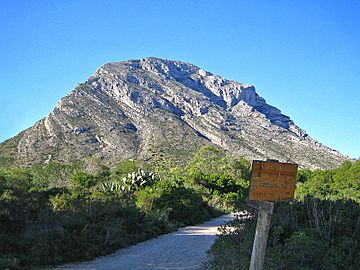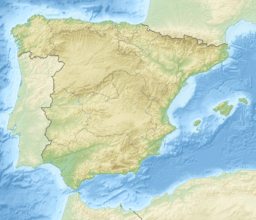Montgó Massif facts for kids
Quick facts for kids Montgó |
|
|---|---|

Montgó massif seen from the plain of San Antonio, Xàbia
|
|
| Highest point | |
| Geography | |
| Location | Marina Alta, Valencian Community |
| Parent range | Prebaetic System, Eastern zone |
| Geology | |
| Mountain type | Limestone |
| Climbing | |
| Easiest route | First drive, then hike from Xàbia or from Dénia |
Montgó (Valencian pronunciation: [moŋˈɡo]) is a special mountain in Alicante Province, Spain. It stands tall at about 753 meters (2,470 feet) high. This mountain is the very last part of the Cordillera Prebética Mountain Range. You can find it in the Marina Alta area, between the towns of Dénia and Xàbia.
Montgó rises sharply from the flat lands around it. It really stands out in the sky for many miles. Its rocky cliffs are home to some unique plants and animals in Spain. People know the mountain for its cool rock shapes, cliffs, caves, and natural harbors. From the Xàbia side, Montgó often looks like the head and trunk of an elephant! You can easily get to the mountain using highway CV-736. This road connects Denia with Xàbia. Both towns are easy to reach by the AP-7 motorway or the N-332 national highway.
There's a fun local story about Montgó. It says that Dénia and Xàbia argued so much over the mountain that one town fell on its face and the other on its bottom. This gave people from these regions their funny nicknames!
Contents
Montgó: A Special Nature Reserve
The Montgó Nature Reserve is a huge protected area. It covers about 2,150 hectares (5,312 acres) around the mountain. This reserve also includes a part of the coast that stretches over 3 kilometers (1.8 miles).
Inside the reserve, scientists have found important old items. These include ancient cave paintings and Phoenician amphoras (old jars). They also found remains of Iberian settlements, which were homes from long ago. Because of its amazing variety of plants, animals, and natural places, the park became an official nature reserve in 1987. The reserve runs almost next to the coastline. It connects to the coast through a flat area called ‘les Planes’. This area ends at Cap de San Antoni.
How Montgó Was Formed
Montgó was created about 70 million years ago. This was during a time called the Cretaceous period. During this time, huge pieces of the Earth's crust, called continental plates, pushed against each other. The African and European plates were forced upwards. This created amazing mountains like Montgó.
Over millions of years, strong wind and water wore down the rocks. Landslides also helped shape the mountain. This is how Montgó got its unique look that we see today. The rocks in this Nature Reserve are mostly from the Cretaceous period. In the lower parts, you'll find soft rocks called marl and marlaceous lime. The steep cliffs are made of hard, strong limestone.
Plants and Animals of Montgó
Montgó's Amazing Plants
The rocks and weather of Montgó have helped over 650 types of plants grow here. The old Mediterranean oak tree used to cover the mountain. People cut down many of them, but some are still here. You can also find Mount Atlas Pistachio, rosemary, white hellebore, rock lavender, marine juniper, and cistus.
In the higher, wetter areas, there are special plants found only here. These include the Hippocrepis Valentina and the Valencian rock violet. You might also see the blue Mediterranean fan palm. This is the only type of palm that grows wild in Europe. Another unique plant is the Carduncellus Dianius, or ‘Hierba Santa’. It grows only here and in Ibiza.
Montgó also has Kermes oak groves. These are small groups of oak trees mixed with mastic trees and rhamnnus alaternus. You'll also see Mediterranean scrub, which is a type of bushy plant. On the very top of the mountain, there is red lavender and Kermes oak. These plants grow where the soil is deeper and more protected.
On the cliffs of Cap de Sant Antoni, plants grow in cracks and shelves. They can handle salty water from the sea. Close to the sea, you'll find Marine Fennel and the everlasting flower, Helichrysum decumbens. As you move away from the sea, the saltiness decreases. Here, the Valencian rock violet appears, along with Cave Scabius on steep slopes. On flatter ground, you can find plants unique to this area. These include the Valencian rock violet and plants like rock thistle and valerian.
On the flat areas and hillsides, lavender and Kermes oak grow. They are mixed with replanted aleppo or carrasco pine trees. You'll also see plants typical of dry land. Shady cliffs are more humid and harder to reach. This helps special plants like Valencian rock violet, Cave Scabius, Sanguisorba ancistroides, and Sarcocapnos saetabensis grow. On wider shelves, you can find Black Sabina and Chamaerops humilis. In sunny areas, plants that like hot, dry conditions grow. These include Chaenorrhinum crassifolium and Teucrium hifacense.
Montgó's Amazing Animals
Many sea birds live here. These include the yellow-footed gull (Larus cachinnans), Sandwich tern (Sterna sandvicensis), and Audouin's gull (Larus audouinii). The peregrine falcon and the Eurasian eagle owl also live on Montgó. You can also spot eagles, ravens, seagulls, and many other migratory birds. In the higher parts, the patiamarilla gull makes its nests. Audouin's gull spends the winter here, along with Bonelli's eagle.
In total, eight types of birds of prey have been seen breeding in the Montgó Natural Park. Four of these birds hunt at night. These are the Eurasian eagle owl, Eurasian scops owl, tawny owl, and the little owl. The other four hunt during the day. These are the goshawk, peregrine falcon, common kestrel, and Eurasian sparrowhawk. They eat many animals that live on the mountain. These include European rabbits, red foxes, toads, snakes, dormice, brown rats, European badgers, common genets, weasels, and bats. It's also likely that common buzzards, short-toed eagles, and the Eleanora's falcon also have babies in the Montgó park.
It's hard for amphibians (like frogs and toads) to find water here. So, they are rare. But you can still find the common toad and the natterjack toad. Reptiles are more common. These include the viviparous lizard, the ocellated lizard, the horseshoe whip snake, and the unique Bedriaga's skink. There are also many types of snails and insects.
People and Montgó: A Long History
People have lived on Montgó for a very long time. The first signs of humans date back about 30,000 years. This was during the Paleolithic period. Small groups of people who moved around lived in the caves and hills facing the sea at Cap de San Antoni. They found food by hunting animals and gathering plants. They also fished a lot. The mild weather helped them survive. You can see proof of these early humans in the famous paintings in Migdia cave. Other old items found on the mountain include Stone-Age hand-axes, flints, Roman pottery, and Muslim ceramics.
There are a few caves in the mountain. The most famous is the Cova de l'Aigua. This small cave was used by the Iberian people in the 4th and 5th centuries as a place to worship. Later, in the 18th century, it was used to store water. At the entrance, there's a Roman writing from the year 238. A Roman soldier carved it. You can reach this cave from the Dénia side.
In the early 10th century, a Moorish ruler named Abd ur Rahman the Third visited Montgó. He traveled all the way from Cordoba to collect over a hundred different medicinal herbs from the mountain slopes.
In the late 1800s, people wanted a lot of raisins. So, farmers started growing Moscatel grapes on the slopes of Montgó. Today, many of these grape fields are empty. It's hard to reach them, and it's not very profitable anymore. But some grapevines still grow. They produce sweet grapes, mostly for a drink called Mistela of the Marina Alta. Some citrus fruits are also grown here.
Montgó's Weather
You might often see clouds forming around the top of Montgó. This happens even when the sky is clear everywhere else. This is called Orographic lift. It means that moist air from the Mediterranean Sea is pushed up the mountain. As it goes higher, it gets colder and turns into clouds. Then, it falls as rain. Even though Montgó looks dry, it gets a good amount of rain. Most rain falls between September and November. However, during the summer, there is often a long period with very little rain.
Climbing Montgó
You can climb to the top of Montgó from any side. The hike takes you through many different natural areas. You'll see rocky ground, farm fields, pine forests, and bushy scrub land. The climb usually takes about four hours. At the very top of Montgó, you can find the remains of the Casa de Biot. This was an Iberian settlement from the 8th century B.C. From the summit, you get amazing views of the coast and the sea. On a clear day, you can even see Ibiza!
Protecting Montgó
Montgó was officially made a Natural Park on March 16, 1987. This happened because of a special rule called Decree 25/87. This rule was made by the Consell of the Generalitat Valenciana. The rule has been updated since then by Ordinance 110/92. Another law, Law 5/88, also helps protect nature reserves in the Province of Valencia.
See also
 In Spanish: Parque natural del Macizo del Montgó para niños
In Spanish: Parque natural del Macizo del Montgó para niños
- Mountains of the Valencian Community


